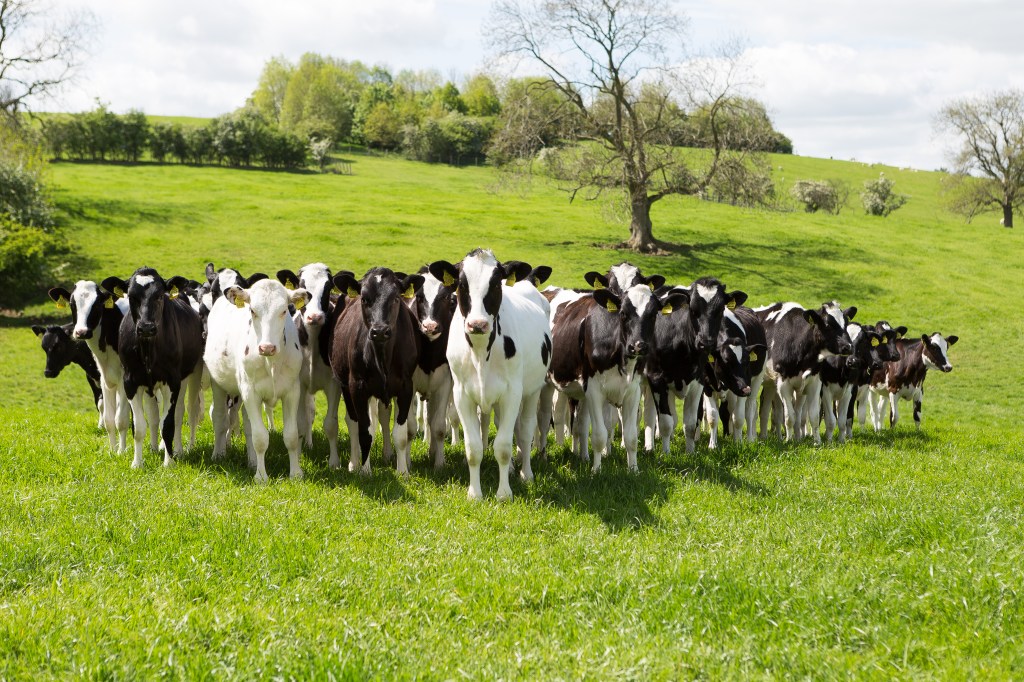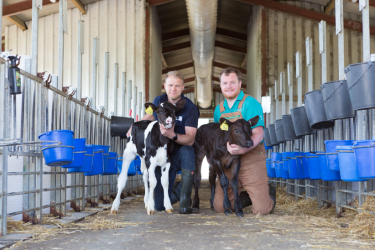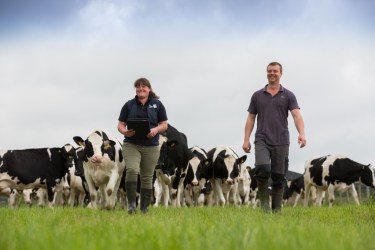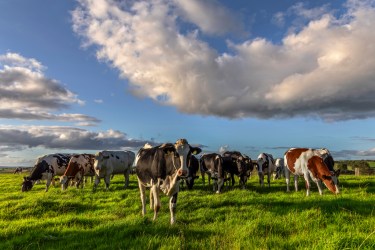Sire selection is a key consideration in genetic strategy for dairy farming. When looking for genetic improvement over several generations, an informed breeding program based on selective breeding for desirable characteristics such as milk production and feed efficiency, is essential for success.
Focusing on the implementation of genetic improvement and reproductive plans to manage inventory can reduce some of the largest cost centers on a dairy farm.
What is genetic selection in dairy cattle?
Genetic selection is the process of understanding the desirable characteristics within a herd, and using these as a basis for creating the best genetic potential for replacements.
This means deciding on the traits, such as milk yield or body weight, that will be best carried forward into the next generation of heifers, and working out which will be the most profitable cows to breed.
Heifer inventory management
Beef on dairy has expanded significantly in the US over the past five years, but that is a very recent development given the long history of breeding beef on dairy in the UK and other parts of the world. Far from being the latest flash in the pan fab, beef on dairy and the use of InFocus semen has proven to be a great tool for managing inventory on a dairy farm.
There’s no denying that there is a certain amount of volatility in the dairy market. Dairy farmers don’t get to choose the price at which they can sell milk, but they can better control other parts of the profitability equation. This includes milk yield, feed and production costs, and diversifying income streams.
While some are still betting on springing heifers to turn to profitable cows, there are likely to be better ways to drive long-term profitability within your herd than feeding extra heifers every year on the gamble that they’ll make money for one year in the future.
Beef on dairy seems a steady alternative. While a beef calf is worth more than an InFocus calf, that beef on dairy calf is still more valuable than a male dairy calf, so it still makes economic sense to breed InFocus calves over dairy ones.
What are the goals of the dairy?
When deciding how to manage the inventory needs of a dairy farm, the key thing to consider is the long-term goal of the farm.
The genetic strategy will be different if the main goal is expansion and increasing herd size than if dairy is at maximum capacity and the main goal is genetic improvement and maximising genetic potential within the herd.
A dairy farm might be looking to create the correct number of replacements for cost efficiency, or it might want to focus its breeding program on maximising profits and return on investment.
Reducing feed costs
The second largest cost center for most dairies is rearing and feed costs. And yet it’s not unusual for farmers to breed and raise more replacement heifers than are actually needed.
This can lead to the cull rate being artificially raised due to the number of heifers freshening, and even situations where profitable cows are leaving the dairy in order to make space for a two-year-old heifer that won’t be profitable until its next lactation.
What lactation number is the most profitable?
There are pros and cons in every lactation.
The best genetics are in young dairy cows, and it’s these that should be bred for replacement heifers. These young cows typically have fewer problems with health, feet and reproduction than the older dairy cows.
But the younger ones are generally not as productive as they don’t peak as high in their first lactation. They’re still growing, so more dry matter goes into their maintenance and growth than into production.
Meanwhile, older cows have already made an impact on the herd’s genetics, with genetic changes over the previous years, contributing to a higher quality mature herd. They typically have more health and reproductive concerns, so striking the right balance is important.
When calculating the most profitable cows in the dairy, it’s likely to be a cow on her third lactation, who has paid for all of her heifer rearing costs in her first and part of her second lactation. She’s still young enough that there aren’t many health issues and she’s still reproductively efficient.
Maintaining the older cows is important, to lower the cost of production, but with enough younger heifers to strike a balance of genetic improvement to maintain herd size.
The exact lactation number for profitability will vary from farm to farm, and depends on herd efficiency, herd size and location, but the general rule of thumb is somewhere in the third lactation.
Genetic strategy for dairy farming
Raising heifers is costly. They come with a high cost of production. Peak milk in the first lactation cows is limited in comparison with the rest of the herd. First lactation cows only produce around 80% of the milk that lactation two, and over, cows produce.
When considering calving in and producing replacements, there are considerations around genetic merit.
For example, in a situation where there are 10 heifers freshening but the dairy doesn’t need 10 to maintain herd size, proper selection can have a huge impact on profits and inventory management. There are two extra heifers that cost feed, labor and other supplies every day.
As an alternative to this, the farm could create eight dairy heifers, and take the two with the lowest genomic scores for beef calves. This does three things:
- It eliminates the costs of raising the two extra heifers that would have given low ROI
- It gives an extra profit stream in selling them as wet calves or feed lock cattle, much quicker than raising them as dairy heifers.
- By removing the two lowest scoring heifers, the overall average genetic score of the remaining dairy cows rises.
Instead of those two heifers costing money to rear and feed, and taking longer to create ROI, they create extra income as beef on dairy calves.
Sexcel® and Beef InFocus™
Using Sexcel® and Beef InFocus™ as part of the genetic improvement program can enable dairy farmers to increase their selection intensity, leading to faster genetic progress.
When the best dairy cow on the farm has a bull calf, the opportunity for genetic progress is lost. When problem cows end up having heifer calves, it can set genetic progress back.
When selectively breeding the best heifers in the herd for replacements, and implementing a strategy of beef on dairy and sexed semen, profitability is maximised.
The aim is to continue to milk older cows that are lower genetic value without having to pass on their genetics to benefit from their low cost of production and high profitability, while making genetic progress with the younger dairy females that have better genetics to pass on to the next generation.
Breeding program for replacements
Determining the number of replacement cows needed in a herd to make up for cows being culled has a number of considerations. The number will vary from farm to farm, and depend on the dairy’s goals.
Abortions and stillbirths, as well as heifers leaving the herd before milking are all factors to be accounted for.
At ABS we have a heifer and pregnancy inventory tool which enables us to create a report to show any dairy their current position, what they can expect their inventory position to be in six months, and to make calculations to decide on how much to reign in or expand their heifer inventory based on their goals.
The tool takes information like herd size, cull rate, and losses in order to calculate heifer creation needs, to give the estimated number of heifers that need to be created month to month. The more detailed the information provided, the more accurate the estimates.
It also compares the current situation of the heifers on-site with the goals for the dairy.
This will raise questions:
- Are there already too many heifers in the pipeline?
- Can some be sold to reduce the cost burden on the farm?
- Would it be better to buy some heifers at a lower cost than raising them?
It can enable us to work with dairies to help them calculate the number of inseminations they need from sexed or conventional semen to create the right number of replacements each month. Beyond that, they can use the Beef InFocus™ semen on the remaining cows each month.
Combining this with a genetic strategy will ensure that the genetic gains are being maximised with the more productive older females continuing to be milked.
Decreasing seasonality
Seasonality causes challenges around cash flow, rearing pen space, feed management, and maternity or transition management leading to increased issues of mastitis and similar health issues due to overcrowding.
This occurs due to seasonal changes in conception rates, natural life cycles of the animals, and purchases of groups of cattle, amongst other factors.
Seasonality can be reduced by:
- Arranging breeding of certain animals at certain times of the year
- Using Beef InFocus™ and Sexcel® at certain times of the year
- Purchasing cattle that are not in the same seasonality as the current herd
- Maintaining a breeding plan that takes seasonality into account
What does this mean for a dairy?
In the space of a few months, the number of extra heifers created can cost hundreds of thousands of pounds in extra raising and feeding expenditure.
Taking out these unnecessary expenses and replacing them instead with the income stream of beef calves could realise several thousands in extra income.
Genetic implementation with proper sire selection and an informed breeding program can help transform a dairy’s profit centres in the short term while making genetic improvements in the long term.






